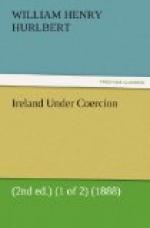The visits to Ireland, of which this book is a record, were made on my return from a sojourn in Rome during the celebration of the Jubilee of His Holiness Leo XIII. What I then and there learned convinced me that the Vatican was on the eve of grappling in Ireland with issues substantially identical with those which were forced, in my own country, two years ago, upon a most courageous and gifted member of the American Catholic hierarchy, the Archbishop of New York, by the open adhesion of an eminent Irish American ecclesiastic, the Rev. Dr. M’Glynn, to the social revolution of which Mr. Henry George is the best-equipped and most indefatigable apostle. Entertaining this conviction (which events have since shown to have been well-founded), I was anxious to survey on the spot the conditions under which the conflict so vigorously encountered by the Archbishop in New York must be waged by the Vatican in Ireland.
To suppose that the Vatican, in dealing with this conflict, either in Ireland or in America, is troubling itself about the balancing of political acrobats, British or American, upon the tight-rope of “Home Rule,” is as absurd as it would have been to suppose that in 1885 the Vatican concerned itself with the subterranean intrigues which there is reason to believe the Irish Nationalists then sought to carry on with the wire-pullers of the two great British political parties. To get a correct perspective of the observations which I came from Rome this year to make in Ireland, my readers, as I have already said, must allow me to take them across the Atlantic, and must put aside as accessory and incidental the forensic and polemic phenomena of Irish politics, with which they are perhaps only too familiar.
It is as easy to go too far back as it is not to go back far enough in the study of such a revolutionary movement as that of which Ireland is just now the arena.
Many and sore are the historical grievances of the Irish people. That they are historical and not actual grievances would seem to be admitted by so sympathetic and minutely well-informed a writer as Dr. Sigerson, when he gives it as his opinion, that after the passage of the Land Act of 1870, “the concession in principle of the demands of the cultivators as tenants” had “abolished the class war waged between landlords and their tenantry.”
The class war between the tenantry and their landlords, therefore, which is now undoubtedly waging in Ireland cannot be attributed to the historical grievances of the Irish people. The tradition and the memory of these historical grievances may indeed be used by designing or hysterical traders in agitation to inflame the present war. But the war itself is not the old war, nor can it be explained by recurring to the causes of the old war. It has the characteristics no longer of a defensive war, nor yet of a war of revenge absolutely, but of an aggressive war, and of a war of conquest. In his able work on “The Land Tenure and the Land Classes of Ireland,” Dr. Sigerson, writing in 1871, looked forward to the peaceful co-existence in Ireland of two systems of land-holding, “whereby the country might enjoy the advantage of what is good in the ‘landlord,’ or single middleman system, and in the peasant proprietary or direct system.”




